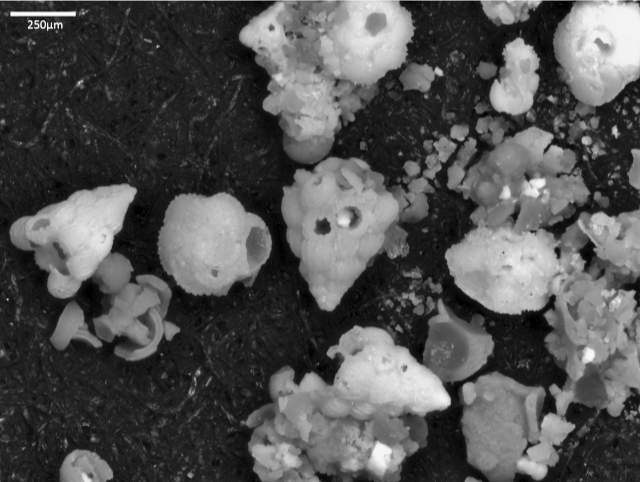
Hull Labs
Over 65 million years ago, a giant meteor— roughly seven miles wide — crash-landed into what is now Mexico’s Yucatán peninsula.
“Right in the middle of the impact crater today is a beautiful town called Mérida,” said Pincelli Hull, a Yale professor of geology and geophysics.
When the meteor struck, the impact ripped a gaping 125 mile-wide crater in the Earth’s crust, which is no longer distinguishable from the unaffected land surrounding it today.
Millions of years ago, when the meteor first crashed down, the impact caused a slew of life-damning changes to the Earth’s environment. According to Hull, many scientists now agree that this meteor caused the most recent mass extinction of life on Earth— the same that killed off the dinosaurs — in the centuries following the impact.
Researchers turned to geology for evidence that directly tied the meteor impact to the subsequent mass extinction. Microfossils — the remains of ancient plankton, which Hull and her team study — provided the first evidence for this theory.
According to Hull, microfossils are the preserved calcium carbonate remains of plankton, a broad term for any floating organism found in water, which include algae-eating protists, sea plants and even a range of animals such as jellyfish. The shelves of Hull’s lab are lined with millions of microfossils. Some of their samples are still embedded in sediment, while others have been extracted and are kept en masse within glass vials.
“The amazing thing is that in a lot of places in the ocean, you can drill down for kilometers and just be drilling down through time, and then pull up millions and millions of [microfossils],” Hull said.
Microfossils are visible to the eye, but are typically shorter than half an inch long, said Leanne Elder, a former researcher in Hull’s lab. Boats similar to oil rigs collect sediment cores containing these fossils from the ocean floor, she said. Sediments found in these cores form distinct layers, and scientists are able to correlate differences in each layer’s composition with the time period in which the layer was formed — especially for those formed during tumultuous events like mass extinctions.
“Microfossils tell you the sequence of events of how things actually go extinct — they allow you to tie together how the temperature changed, how much the acidity of the water changed, and then what happened to the species themselves,” Hull said. “So they let you put together the causes and the consequences of extinctions.”
Scientists found little glass spheres — typical formations from massive explosions — in ocean sediment layers that contained less diverse microfossils. After the discovery, the theory that a meteor impact caused a mass extinction of life on Earth gained momentum among scientists.
Any massive explosion or impact, like the detonation of an atomic bomb, will generate enough force to turn rock into molten glass. And the meteor impact 65 million years ago was not an exception.
“[The meteor] hit so hard that the rock turned into essentially glass — it was molten,” Hull said. “It went from rock to liquid glass, and that got thrown up into the sky. So then the sky essentially had these little tiny droplets of molten rock, and those little tiny droplets of molten rock rained down from the sky.”
The smallest of these droplets, called tektites, were carried thousands of miles away from the impact site and fell into the ocean. From there, the little glass balls solidified and settled to the seabed, where they were preserved with ancient plankton.
Scientists found the first of these deep-sea sediments embedded with tektites off the coasts of Denmark and in the mountains of Italy. In just inches of sediment, these samples provided a visual timeline of the extinction: Numerous, diverse microfossils were embedded into the older formations, and then over a layer sprinkled with tektites, few microfossils can be seen.
“It’s so visual — you don’t need to know anything about the species you’re looking at to realize that something big happened,” Hull said.
Samples like the ones found in Italy and Denmark revealed the general length of the extinction. And later, more evidence tied the meteor impact to layers of the sample which lacked microfossil diversity.
Hull said that an element called iridium typically falls to earth from space at a constant, predictable rate. But iridium is also abundant on meteorites, and scientists found unusually massive amounts of this element within the sparse layer of the samples found in Denmark and Italy. Scientists theorized that when the meteor collided with Earth, iridium and other particles were sent into the air, which then settled on the seafloor and were incorporated into the fossil samples, according to Elder.
“The increased iridium combined with the impact crater, and a few other forms of evidence, is what supports the hypothesis of an exterritorial impact leading the extinction event at the time,” Elder wrote in an email.
The first Brontosaurus discovered after this mass extinction is currently on display at Yale’s Peabody Museum of Natural History.
Marisa Peryer | marisa.peryer@yale.edu .







